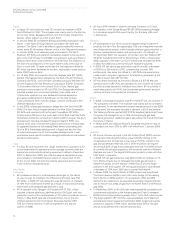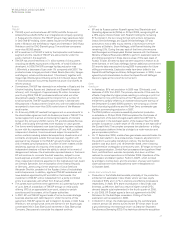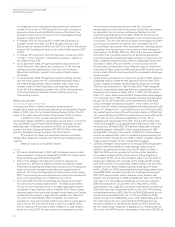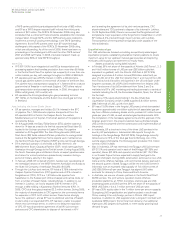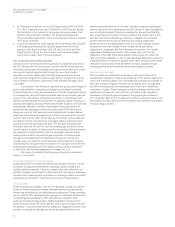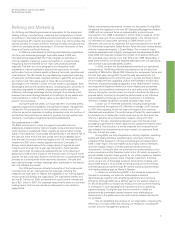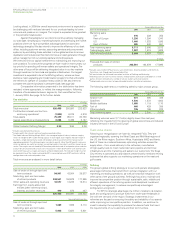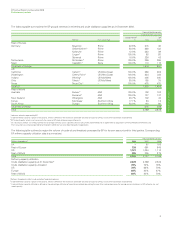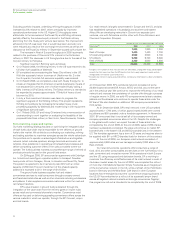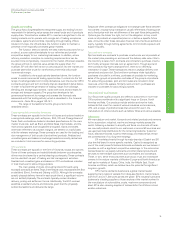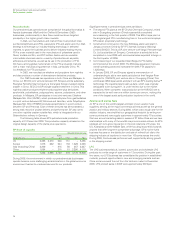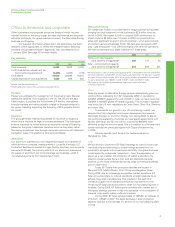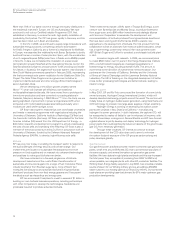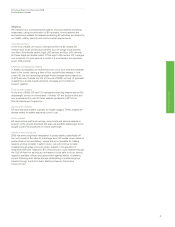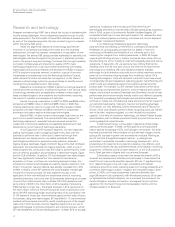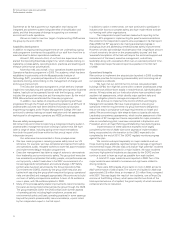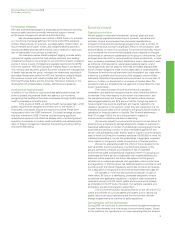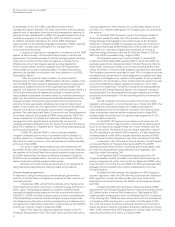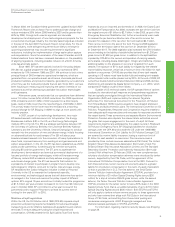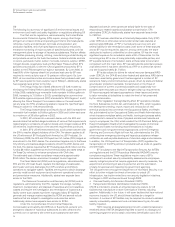BP 2008 Annual Report Download - page 37
Download and view the complete annual report
Please find page 37 of the 2008 BP annual report below. You can navigate through the pages in the report by either clicking on the pages listed below, or by using the keyword search tool below to find specific information within the annual report.
BP Annual Report and Accounts 2008
Performance review
Petrochemicals
Our petrochemicals operations are comprised of the global Aromatics &
Acetyls businesses (A&A) and the Olefins & Derivatives (O&D)
businesses, predominantly in Asia. New investments are targeted
principally in the higher growth Asian markets.
In A&A, we manufacture and market three main product lines:
purified terephthalic acid (PTA), paraxylene (PX) and acetic acid. Our A&A
strategy is to leverage our industry-leading technology in selected
markets, to grow the business and to deliver industry-leading returns.
PTA is a raw material used in the manufacture of polyesters used in
fibres, textiles and film, and PET bottles. Acetic acid is a versatile
intermediate chemical used in a variety of products such as paints,
adhesives and solvents, as well as its use in the production of PTA.
We have a strong global market share in the PTA and acetic markets
with a major manufacturing presence in Asia, particularly China. PX
is a feedstock for PTA production.
In O&D, we manufacture ethylene and propylene from naphtha
and also produce a number of downstream derivative products.
Our O&D business has operations in both China and Malaysia. In
China, our SECCO joint venture between BP, Sinopec and its subsidiary,
Shanghai Petrochemical Company is the largest foreign-invested olefins
cracker in China. SECCO is BP’s single largest investment in China. This
naphtha cracker produces ethylene and propylene plus derivatives
acrylonitrile, polyethylene, polypropylene, styrene, polystyrene, and other
products. In Malaysia, BP participates in two joint-ventures: Ethylene
Malaysia Sdn. Bhd. (EMSB), which produces ethylene from gas feedstock
in a joint venture between BP, Petronas and Idemitsu; while Polyethylene
Malaysia Sdn. Bhd. (PEMSB) produces polyethylene in a joint venture
between BP and Petronas. Each of these ventures has demonstrated a
strong track record of project delivery and performance. BP also owns
one other naphtha cracker outside Asia, which is integrated with our
Gelsenkirchen refinery in Germany.
The following table shows BP’s petrochemicals production
capacity at 31 December 2008. This production capacity is based on the
original design capacity of the plants plus expansions.
BP share of capacity
thousand tonnes per year
Acetic
Geographic area PTA PX acid Other O&D Total
US 2,385 2,373 546 151 – 5,455
Europe 1,075 622 544 158 1,629 4,028
Asia (excluding China) 2,209 – 815 56 257 3,337
China 1,554 – 215 51 2,290 4,110
7,223 2,995 2,120 416 4,176 16,930
During 2008, the environment in which our petrochemicals businesses
operate became more challenging as deterioration in the global economic
environment has led to a reduced demand for our products.
Significant events in petrochemicals were as follows:
• The second PTA plant at the BP Zhuhai Chemical Company Limited
site in Guangdong province (China) successfully completed
commissioning in the first quarter of 2008. This 900+ ktepa plant is
the single largest PTA manufacturing train in the world and employs
BP’s latest, proprietary technology.
• Construction continued on the new 500ktepa acetic acid plant in
Jiangsu province (China) by BP YPC Acetyls Company (Nanjing)
Limited (BYACO). This is a BP joint venture with Yangzi Petrochemical
Co. Ltd (a subsidiary of Sinopec). Construction is scheduled to be
completed in June 2009 with commercial sales expected to begin in
the third quarter of 2009.
• Commissioning of our expanded Geel (Belgium) PTA facility
commenced at the end of 2008. The 350ktepa expansion improves
overall operating costs and increases the site’s PTA capacity to
1,425ktepa.
• In January 2008, BP and Sinopec signed a memorandum of
understanding to add a new acetic acid plant at their Yangtze River
Acetyls Co. (YARACO) joint venture site in Chongqing (China). This
world-scale (650ktepa) acetic acid plant will use BP’s leading Cativa™
technology. The expected plant start-up date, which was originally
anticipated to be during 2011, is under review due to the market
conditions. When complete, total production at the YARACO site is
expected to be well over one million tonnes per annum, making this
one of the largest acetic acid production locations in the world.
Aviation and marine fuels
Air BP is one of the world’s largest and best known aviation fuels
suppliers, serving all the major commercial airlines as well as the general
aviation and military sectors. During 2008, which was a tough year for the
aviation industry, we simplified our geographical footprint by exiting non-
core countries and now supply customers in approximately 70 countries.
We have annual marketing sales in excess of 27 billion litres and we have
relationships with many of the world’s major commercial airlines. Air BP’s
strategic aim is to grow its position in the core locations of Europe, the
US, Australasia and the Middle East, while focusing its portfolio towards
airports that offer long-term competitive advantage. BP’s marine fuels
business focuses on the distribution and sale of refined fuel oils to the
shipping industry at locations in more than 100 ports across the world.
During 2008, this business performed well, supported by strong growth
in the shipping market.
LPG
The LPG business sells bulk, bottled, automotive and wholesale LPG
products to a wide range of customers in 13 countries. During the past
few years, our LPG business has consolidated its position in established
markets, pursued opportunities in new and emerging markets such as
China and announced the exit from the Vietnam market in December
2008. LPG product sales in 2008 were approximately 68mbpd.
36


